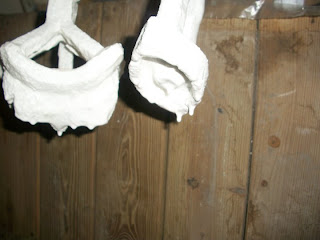First, lets cover what I'm talking about here.
In lost foam casting I am using a piece of foam as a pattern. The liquid metal is poured directly into the foam causing it to evaporate away and leaving the metal to take it's form. Until I discovered what a 'refractory coating' is I assumed I had to pack the pattern into high detail sand like the Petrobond, which I assumed would cause deformation of the pattern. Not so, with refractory coating. You dip the foam piece into this slurry and allow it to dry, this creates a limestone shell around the foam piece. This means the metal will not actually touch the sand directly but instead the line of demarcation is the shell. THIS means that the detail in place of the coating is the detail left on the final part, which turns out to be VERY fine!
A foam length was split into four branches and hot glued to the mask at 4 places to allow multiple avenues of metal ingress and gas egress.
I decided to attach an additional egress vent. It turns out that this was a good idea, but should have been placed at the end of the part (the teeth).
I found this stuff at Home Depot. The MSDS read pretty well and I felt confident that the mechanical properties I needed (no flash point and dries detailed). I mixed up a big tub of it and let it sit for a bit to thicken.
Dip the parts and don't forget that foam floats!
Hang the parts to dry for at least a few hours.
Here was an attempt to do a few different disparate parts through a lost foam gate system, all coated in refractory.
A trick I learned was to use a steel riser around the ingress posts to increase the gravity force pushing the metal through the pattern. It's best to use something hinged so you don't have to beat the hell out of it to get your ingot back. I have also been cutting divots into the foam to aid the start of the foam burning.
Pour the metal directly into the steel collar.
Now THAT is a wee bit disturbing.....
Partial success on the multipart cast. The foam gates appear to have had some gap between components, causing refractory to form and create barriers that didn't allow the metal to flow through.
This piece took out the entire foam pattern and the liquid metal actually came out the egress sprue properly.
The mask also came out complete.
The texture on the mask really is a bit puzzling.
Some things went well, some did not. First, the level of detail that was captured using generic sand was pretty amazing. Even with the pebble texture in the mask you can clearly see places in the final part where a razor knife cut too deeply into the foam of the initial pattern. The limestone shell seems to have held up except for where the egress was not at the highest point in the pattern. I think the pebble texture is either foam gas that could not escape or possibly malformation of the inside of the limestone shell by uneven drying. I also conclude that the type of foam we have been using may be a huge part of the problem, and have since moved to the blue and pink foam for the next battery of tests. I also found the bottom of patterns lost definition and detail, and I think it's due to the weight of the metal causing the limestone shell to balloon out a bit.
I would love to try another brand of texturizer in combination with other types of foam. I am also interested in trying to rotate objects slowly as they dry to create a more even refractory coating. It is possible that the best way to apply is to airbrush the coating onto the foam pattern.














1 comment:
I ran into a neat trick while studying the IG-88 Home Brewed Linear Bearing, which was using drywall texturizer as a refractory coating in Lost Foam casting. grit blasting
Post a Comment